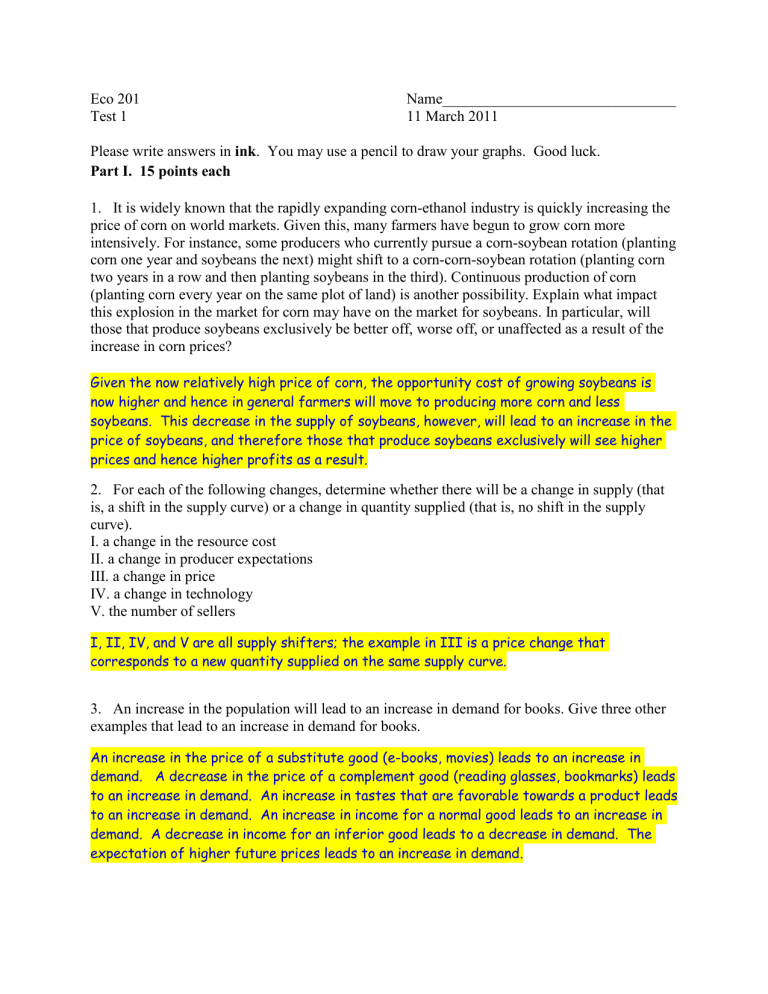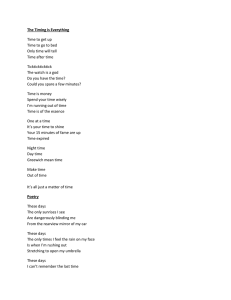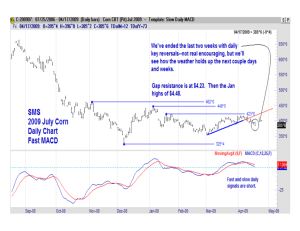Eco 201 Name_______________________________

Eco 201
Test 1
Name_______________________________
11 March 2011
Please write answers in ink . You may use a pencil to draw your graphs. Good luck.
Part I. 15 points each
1. It is widely known that the rapidly expanding corn-ethanol industry is quickly increasing the price of corn on world markets. Given this, many farmers have begun to grow corn more intensively. For instance, some producers who currently pursue a corn-soybean rotation (planting corn one year and soybeans the next) might shift to a corn-corn-soybean rotation (planting corn two years in a row and then planting soybeans in the third). Continuous production of corn
(planting corn every year on the same plot of land) is another possibility. Explain what impact this explosion in the market for corn may have on the market for soybeans. In particular, will those that produce soybeans exclusively be better off, worse off, or unaffected as a result of the increase in corn prices?
Given the now relatively high price of corn, the opportunity cost of growing soybeans is now higher and hence in general farmers will move to producing more corn and less soybeans. This decrease in the supply of soybeans, however, will lead to an increase in the price of soybeans, and therefore those that produce soybeans exclusively will see higher prices and hence higher profits as a result.
2. For each of the following changes, determine whether there will be a change in supply (that is, a shift in the supply curve) or a change in quantity supplied (that is, no shift in the supply curve).
I. a change in the resource cost
II. a change in producer expectations
III. a change in price
IV. a change in technology
V. the number of sellers
I, II, IV, and V are all supply shifters; the example in III is a price change that corresponds to a new quantity supplied on the same supply curve.
3. An increase in the population will lead to an increase in demand for books. Give three other examples that lead to an increase in demand for books.
An increase in the price of a substitute good (e-books, movies) leads to an increase in demand. A decrease in the price of a complement good (reading glasses, bookmarks) leads to an increase in demand. An increase in tastes that are favorable towards a product leads to an increase in demand. An increase in income for a normal good leads to an increase in demand. A decrease in income for an inferior good leads to a decrease in demand. The expectation of higher future prices leads to an increase in demand.
4. Using the “thinking at the margin” concept explain a student's decision to wake up and attend an 8 AM class in the winter (the student is already registered for the class).
On the one hand, the student will stand to gain extra knowledge from the single session of the class. If the subject is interesting, and the teacher is good, this is equivalent to an hour of enjoyment and learning. On the other hand, the student is sleepy, and it is cold and uncomfortable outside. If the class has no attendance policy, and there is no exam scheduled and no assignment due, the student may feel that she has nothing to lose by missing one class. Weighing the marginal costs versus the marginal benefits, the student may thus opt to sleep in! A penalty associated with non-attendance when there is no exam scheduled or no assignment due raises the marginal cost of non-attendance.
Part II. 20 points each.
1. What is the cost of attending college? Explain.
The economic cost of a decision depends on both the cost of the alternative chosen and the benefit that the best alternative would have provided if chosen. Economic cost differs from accounting cost because it includes only opportunity costs.
As an example, consider the economic cost of attending college. The accounting cost of attending college includes tuition, room and board, books, food, and other incidental expenditures while there. The opportunity cost of college also includes the salary or wage that otherwise could be earned during the period. So for the two to four years an individual spends in school, the opportunity cost includes the money that one could have been making at the best possible job. To calculate the economic cost of college requires adding the opportunity costs of attending college. These include the (1) income not earned, and (2) tuition and books, because this is money that could have been spent on other goods and services. The costs of room and board are not costs of attending college, because these costs are incurred whether or not you attend college.
Thus, if attending college has a direct opportunity cost of $20,000 dollars for tuition and books a year for four years, and the lost wages from not working during that period equals
$25,000 dollars a year, then the total economic cost of going to college would be $180,000 dollars ($20,000 x 4 years + $25,000 x 4 years).
2. In the Economics of Public Issues , “Sex, Booze, and Drugs,” the authors contend that
“proscriptions against trade can also lead to socially costly side effects.” They identify five costly side effects. Please identify and explain three of them.
Reduction in the quantity of illegal goods demanded is the hoped-for effect of
Page 2
prohibition; however, proscriptions against trade can also lead to socially costly side effects. First , in any market, the gains from voluntary trade are greatest when people specialize in the activities in which they have a comparative advantage. Criminals have a comparative advantage in producing and selling illegal goods. Consequently, they are attracted to these markets and frequently use violence to enforce illegal agreements. As a result, risk to the buyer increases.
Second , prohibitions against trade impose (or threaten to impose) penalties on sellers and buyers that change the relative prices of illegal substitutes. For sellers, this results in a shift toward trade in compact and high potency substitutes that are easy to transport and conceal, and that yield high profits per unit sold. A case of beer and a fifth of Scotch both have approximately the same alcohol content, yet the Scotch is far easier to conceal from the legal authorities, so its sale yields higher expected profits than does the beer.
For buyers, as penalties against drug use increase, users remaining in the market are more likely to shift from frequent marijuana use (low-level intoxication; easy to detect) to infrequent but intensive cocaine use (high-level intoxication; hard to detect ). Such shifts in consumption patterns toward high-potency illegal drugs and alcohol increase rates of addiction and death resulting from overdoses .
Third , selective enforcement programs lead to an increase in demand for illegal substitutes that are less stringently enforced. Operation Intercept, President Nixon’s massive attempt to interdict imported marijuana, virtually created the domestically-produced sinsemilla (a highly potent form of marijuana) industry; it also prompted smugglers to bring in cocaine instead of marijuana.
Fourth , prices of complementary goods also play a role in illegal markets. For example, suppose that the government distributes free syringes to drug addicts in an attempt to prevent transmission of the AIDS virus by means of contaminated needles. Because syringes are complementary to heroin and cocaine use, when the price of syringes falls, economic theory predicts that the demand for complementary drugs will increase; this reasoning has played a key role in the federal government’s opposition to needle-exchange programs in the United States.
Finally , buyers in illegal markets are placed at high risk regarding product quality . In unrestricted markets, information flows freely and buyers can “punish” sellers by not purchasing mislabeled or low quality products. In illegal markets, information is unreliable and buyers have no legal recourse when harmed by products .
Page 3






